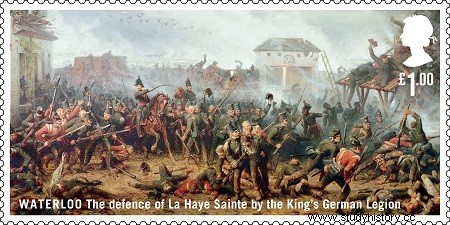
The King's German Legion or K.G.L is the name that designates all the Hanoverian military units formed in the United Kingdom of Great Britain and Ireland between 1803 and 1816.
Origins
In 1714, Anne, Queen of Great Britain and Ireland died without leaving an heir. In application of the act of succession of 1701, the rights to the crown went to the descendants of King James I. This is how the Elector of Hanover Georg-Ludwig became King of England as George I. Hanover, Great Britain and Ireland therefore shared the same sovereign. This situation will end in 1837, when Queen Victoria ascends the throne of England, the application of the Salic law prohibiting the transmission to the women of the crown of Hanover.
In 1803, the Kingdom of Hanover was invaded by French troops under General Mortier. The Hanoverian army was disbanded. Many Hanoverian soldiers who wanted to continue the fight against Napoleon emigrated to England. For reasons of linguistic convenience (they spoke German), they were grouped into Hanoverian units that were formed.
The United Kingdom of Great Britain and Ireland then set up a recruitment system. The son of King George III, the Duke of Cambridge, who, by delegation from his father, administered the Hanoverian territory, invited by a proclamation "all the brave Hanoverians" to join him. Recruitment agents infiltrated in Germany organized the transport of the candidates and paid them the hiring bonus.
Composition
Hanoverian units were integrated into the British Army. There was no proper staff of the King's German Legion, so they never fought under a single command.
From 1805, the Legion included four infantry battalions, two dragoon regiments, five artillery batteries. These numbers continued to increase thereafter.
At its peak in 1812, the KGL had 18,000 men, comprising two regiments of dragoons, three of hussars, eight battalions of line infantry, two of light infantry, six batteries of artillery and engineers.
All Legion units were elite units. Contrary to the British who entrusted the instruction of the troop only to non-commissioned officers, the officers of the KGL were completely involved in it.
Campaigns
Legion units entered Hanover in 1805 with other British troops, when the Austrians and Russians were fighting the French. The French victory at Austerlitz forced them to re-embark, but they took the opportunity to recruit.
They participated in the Spanish Civil War (Battle of Corunna, Battle of Buçaco, Battle of Barrosa, Battle of Fuentes de Oñoro, Battle of Albuera, Siege of Ciudad Rodrigo, Battle of Arapiles, Siege of Burgos, Battle of Vitoria, San Sebastian), at the Battle of Nivelle, and in Sicily.
After the abdication of Napoleon, the units were to be disbanded but the return from the island of Elba justified their maintenance. KGL units under the command of George Baring fought at the Battle of Waterloo (Ferme de la Haie Sainte, among others)
